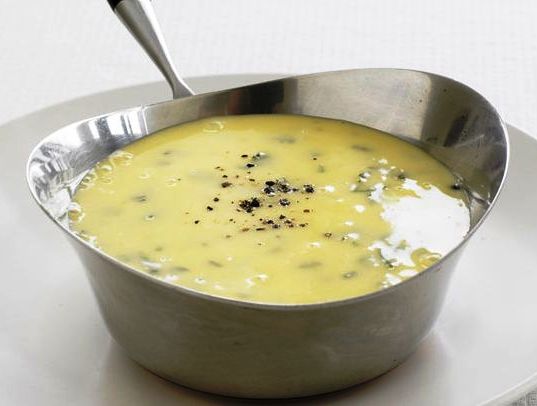Bearnaise Sauce
Description
Try this Bearnaise Sauce, very smooth, creamy and tangy. Bearnaise sauce is a great compliment for meat, poultry and vegetables.
Ingredients
- 1/4 cup chicken broth
- 1/4 cup white wine vinegar
- 4 egg yolks
- 1/4 cup shallots, minced
- 1/2 cup butter, melted and cooled
- 2 tbsps cold water
- 3 sprigs fresh tarragon
- 1/4 tsp ground black pepper
- 1/4 tsp salt
- 1/8 tsp white pepper
- 2 tbsps fresh tarragon, minced
- 1 tbsp fresh parsley, minced
Instructions
In a saucepan, combine the white wine vinegar, chicken broth, shallot, taragon sprigs and black pepper. Bring to a full boil. Then reduce heat and simmer for 10 minutes until mixture is reduced by half. Strain and set liquid aside. Discard solids.
In a separate heavy saucepan, whisk together the egg yolks, water, salt and white pepper with the reserved vinegar liquid from the previous step. Cook and stir over low heat until the mixture begins to thicken. Look for bubbles around the edges, the liquid should reach about 160°.
Gradually whisk in the cooled, melted butter. Remove from the heat and stir in the tarragon and parsley. Serve immediately.
Yields about 1 cup.
Notes
Bearnaise sauce can be tricky to get right. The biggest challenges are "how to avoid curdling" and "how to prevent separation". Bearnaise sauce is an oil-in-water emulsion (the sauce is water-based in which you are trying to get droplets of oil to disperse).
One technique that will help is to use a double boiler in order to keep the heat low and even. It's actually pretty difficult to get it to work consistently in a saucepan. If you want to use a saucepan instead of a double-boiler, adding the butter after you cook the sauce down helps, otherwise you're almost sure to coagulate the yolk before you get started.
Typically, the egg yolk proteins begin to coagulate at around 160°. One trick that can help is to lower the pH to around 4.5 which is accomplished by adding the vinegar. With a lower pH, the coagulation begins at a higher temperature, around 195°, which helps keep the sauce smooth and prevents the separation.
- Login or register to post comments
- Print 8.5x11
- Print 4x6 Index Card
- Print 5x8 Index Card
- Trackback URL


